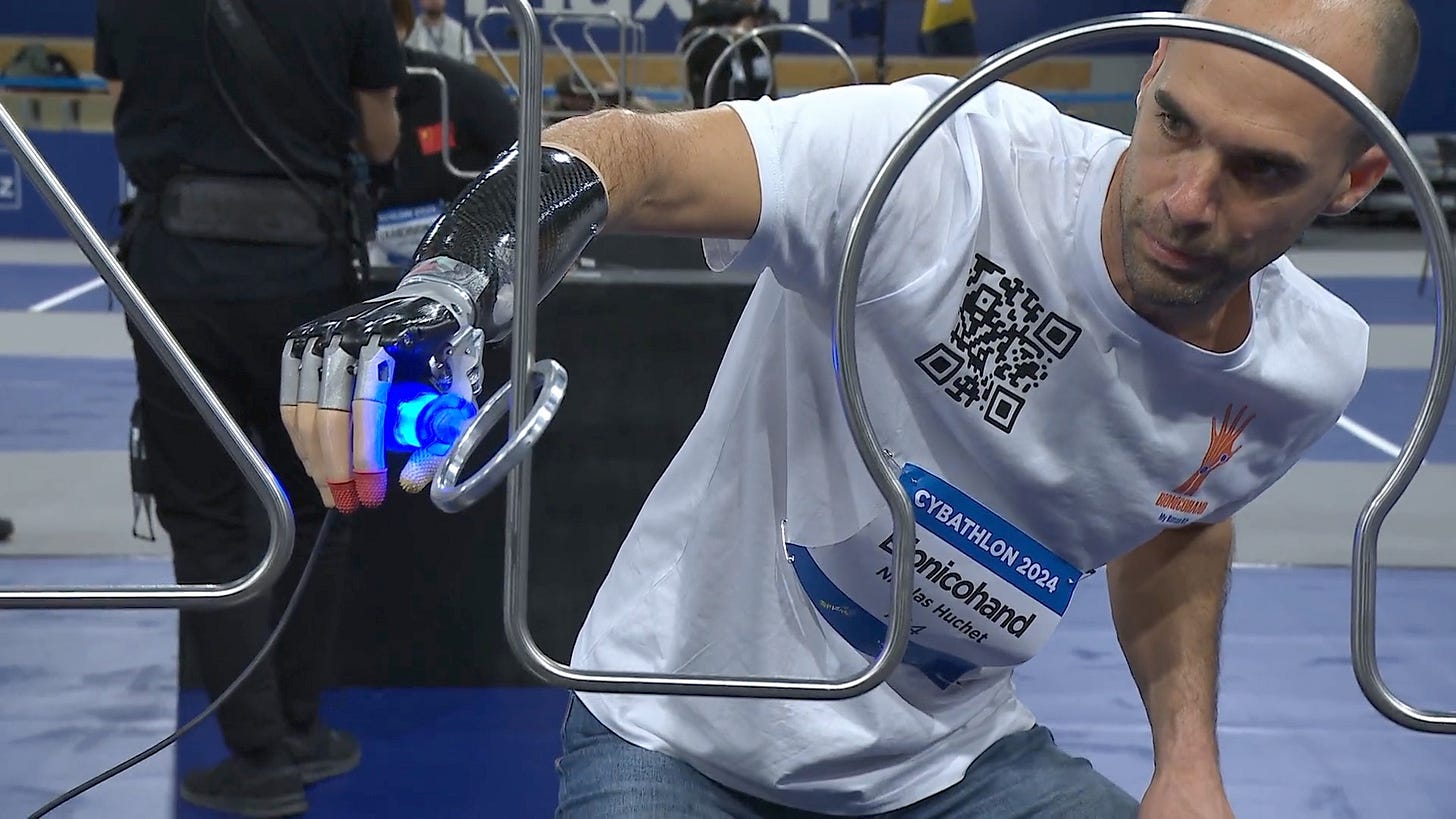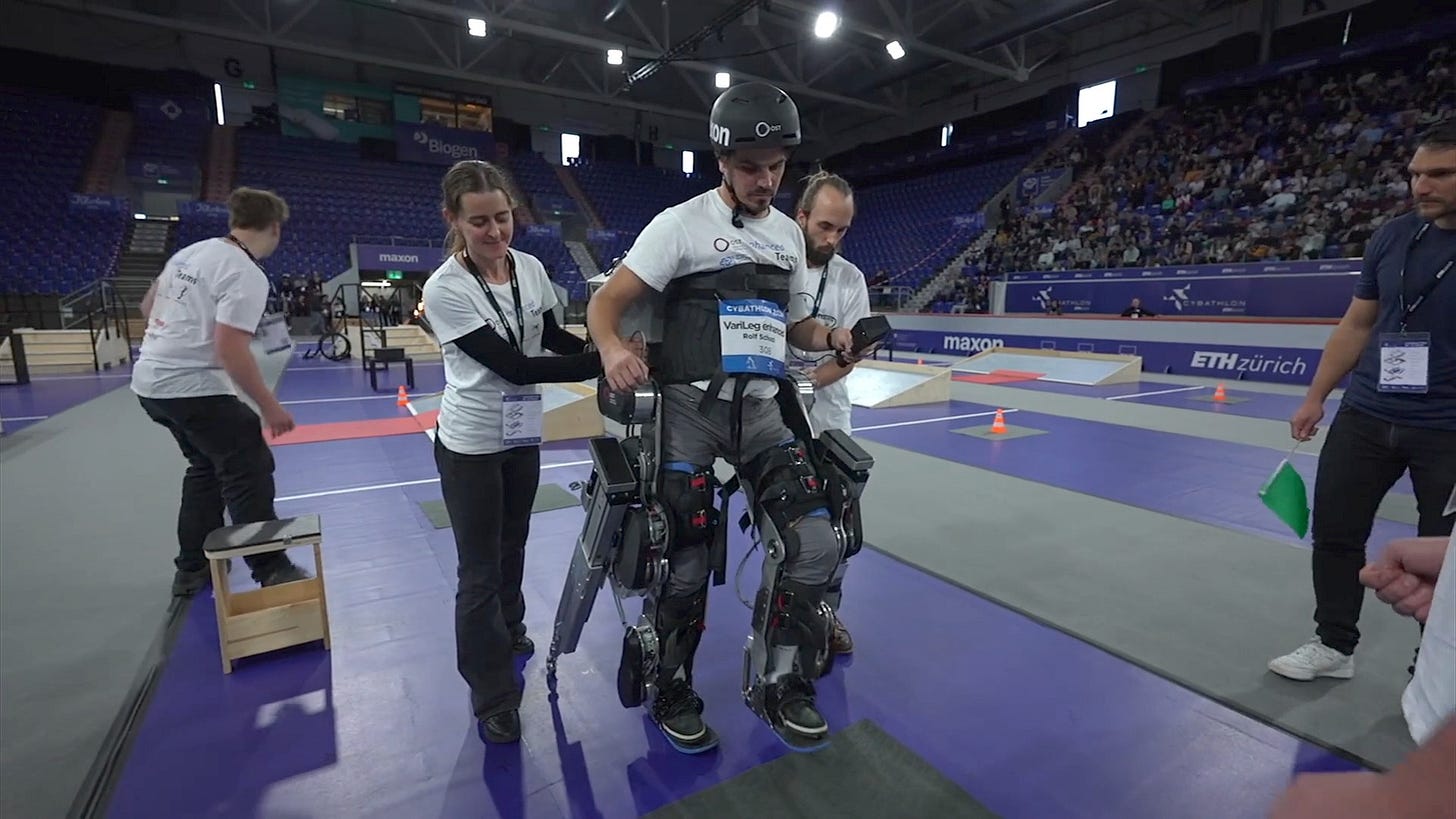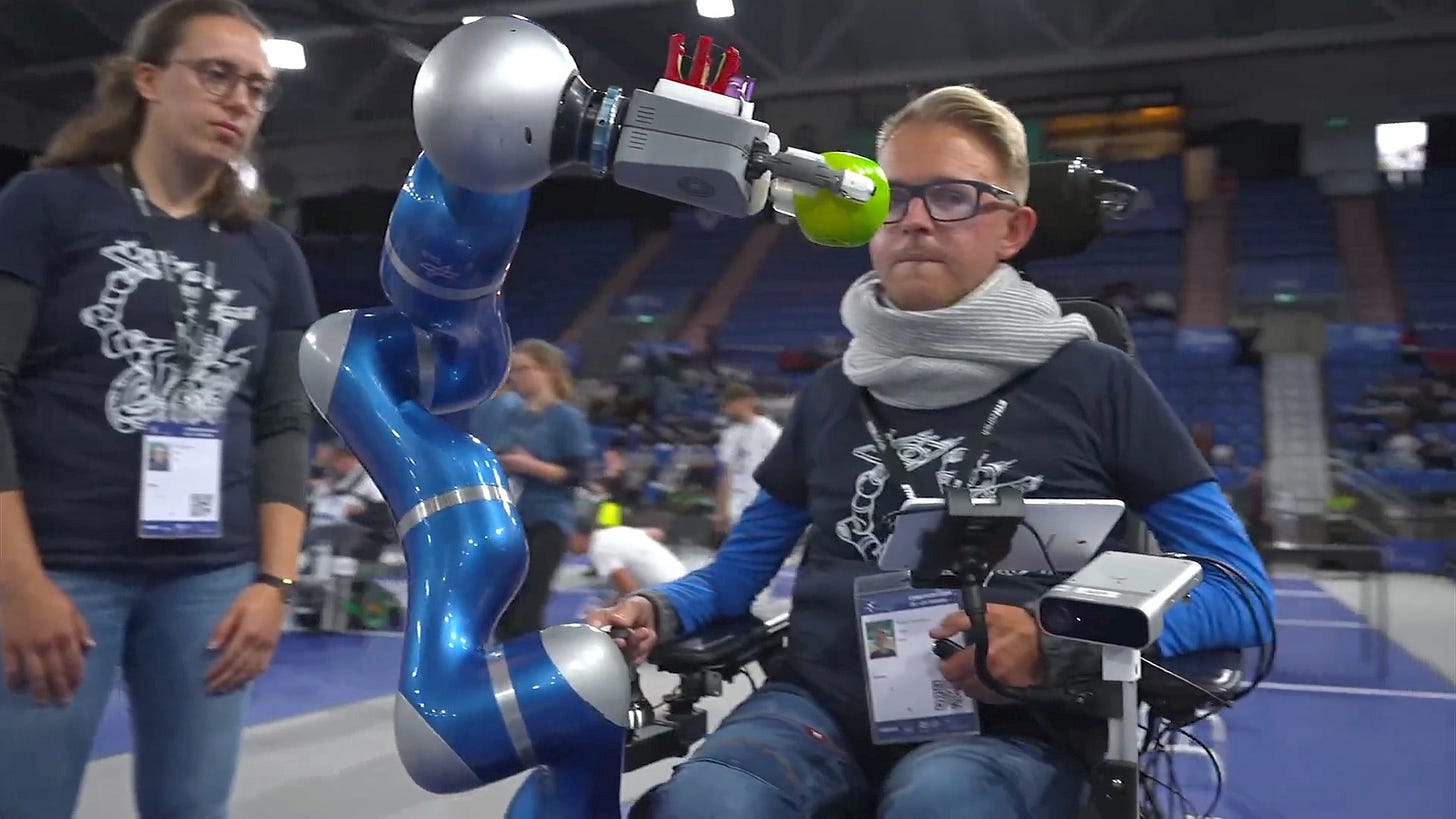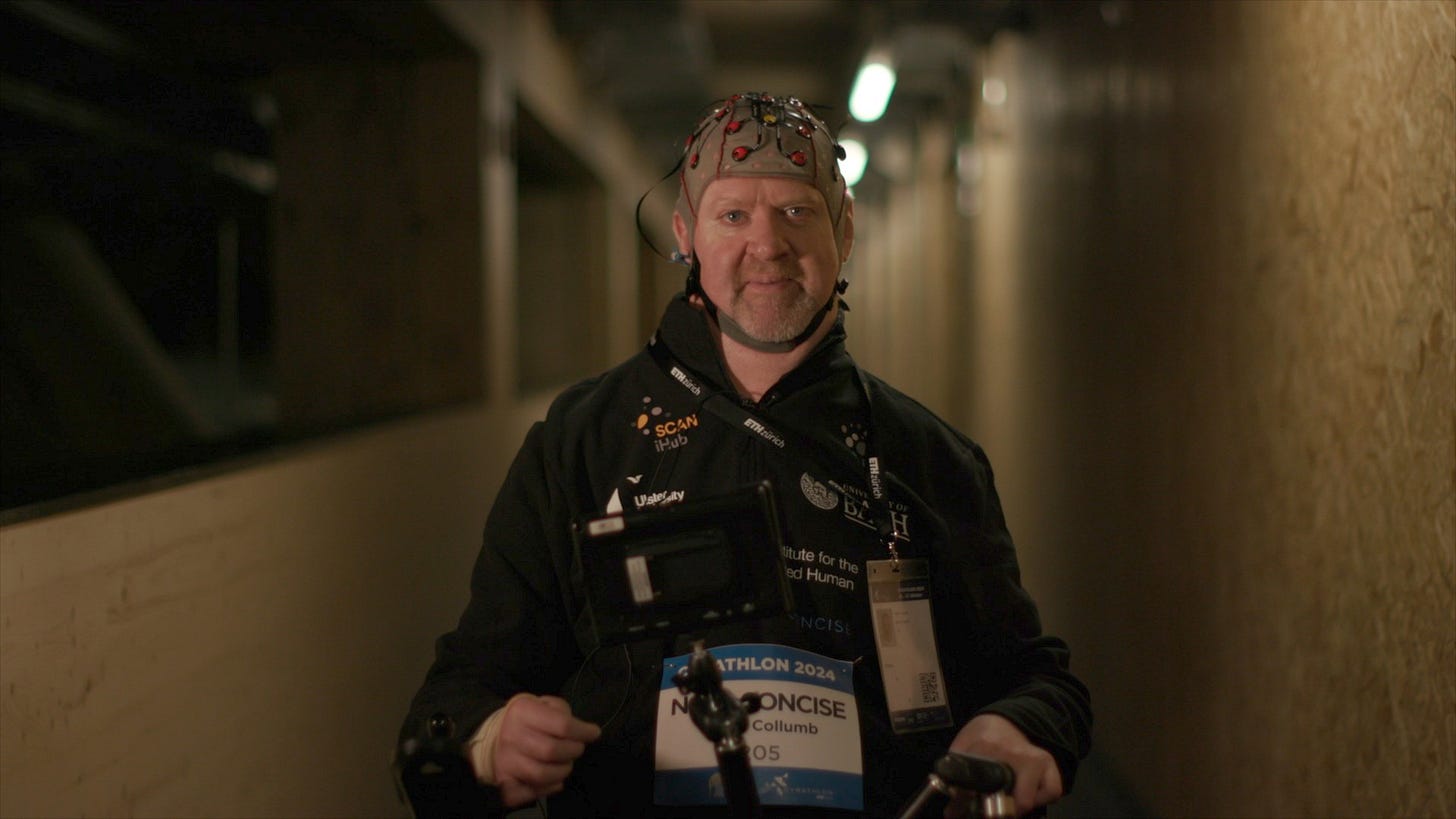I’m pretty sure I've just witnessed the birth of a new Marvel supervillain. Rolf Schoch’s wheelchair is rising up in front of me, while also growing a pair of legs.
You can keep your Olympics, and your Paralympics. Yes, they’re all about elite athletes pushing themselves to the limit. But me, I’m all about Cybathlon - the Cyborg Olympics.
Where else would you get people with robotic arms racing to unscrew bottles, paralysed cyclists pedalling bikes using electrical muscle stimulation, or robot dogs leading their owners between whirling plastic spikes?
I’ve just come back from Cybathlon 2024, and it’s given me an inspiring, but also grounding, update on the latest research into assistive technology for disabled people. I got to see loads of innovation, but also I got an understanding of the big challenges still ahead.
The first Cybathlon took place in 2016, in a stadium in Kloten, just outside Zürich. Lara and I filmed the show on the arena floor, in front of a crowd that whooped and cheered those inaugural races. The atmosphere was pretty electric, and we ended up yelling ourselves hoarse during some pretty tight finals. In the eight years since, the technology has improved, and the challenges have gotten tougher.
Unlike mainstream sporting events, this one isn’t full of sprints, hurdles and long-jumps. Each of the eight disciplines is an obstacle course challenging competitors to a series of everyday tasks, which have been designed to drive forward the development of devices that can help in the real world.
And of course this isn’t just about individual athletes - the pilots, as they’re known, are disabled people operating, wearing or driving the robotic suits and appendages, but they’ve worked with teams of roboticists and designers to come up with the equipment they’re using.
And what’s interesting is that although there are strict rules for each discipline, there is still a lot of room for variation. The point of this is not to perfect a particular design, but to experiment with different designs to see which may be the best in the first place.
Hence, although most of the exo-skeleton race pilots are wearing two legged robotic suits and using crutches, Rolf Schoch’s suit is like nothing I’ve ever seen before - a four-legged robospider that means he doesn’t need crutches, leaving his hands free for completing the other tasks in the race.
As if to make the point, he throws a cheeky wave to the crowd as his suit ambles forward.
And in the robot assistance race, in which pilots in wheelchairs are challenged to carry packages, unload dishwashers, and hang washing, Sammy Kunz is another stand-out entrant. While the other competitors are driving chairs fitted with robotic arms, Sammy has turned up with two robot dogs, named Dingo and Donkey. Sammy steers his chair with his hand, and controls his hounds by sucking and blowing into different mouth-tubes, apparently in the same way he plays Mario Kart.
With a level of mental gymnastics that would make my head go numb, Sammy commands Dingo’s robot arm to hold up a toothbrush to his mouth, while seemingly at the same time sending Donkey on ahead to get ready for the next task. And then all three of them make their way through what I’m calling The Spinning Robots of Death. These rotating red arms test the pilot’s timing, speed and agility - they’re designed to simulate having to dodge past people in a busy restaurant without bumping into them. It’s a bit like Total Wipeout if I’m honest, and I do find myself secretly wishing the arms were spinning fast enough to knock the competitors into the audience.
Each Cybathlon event has its own personality - its own unique feeling. There are riotous cheers for some of the races, but then complete silence during the vision assistance challenge. Here, blind pilots use a combination of different equipment to navigate the course, and they need quiet in order to hear their devices talk them through it. Their kit needs to be multi-skilled, to help them avoid obstacles, find and identify objects, and also read text. Once again, all the tasks are chosen to represent life’s daily challenges, including reading product labels in shops, finding a spare seat on a train, and even choosing matching clothes to wear.
As I watch a competitor sort fabrics into different colours, and then into lighter and darker shades, I’m reminded of that time as a student when I arranged my CD collection into colour order. It was completely useless - I couldn’t find anything. It looked good though.
Spencer Kelly on the Edge
I’ve talked before about my love of universities - it’s where I’ve found an openness to research that has yet to be too influenced by commercial considerations. This is where real blue-sky thinking happens, where the embryos of world-changing ideas gestate, and where you’re allowed to tinker, to have fun, and, importantly, to fail.
In the run-up to the first Cybathlon in 2016, I got the chance to hang out with some students who were testing an early prototype of a stair-climbing wheelchair. And “hang out” I most certainly did - over a set of steps, after the machine broke down, leaving me suspended over what felt like a much bigger drop than it looked on the video. My cameraman filmed the whole shameful episode, as I begged the team first to get me down, and then not to get me down, when it became apparent that their rescue plan seemed to be just to kill the power and see what happened.
I’ve shared it before, but I’m sharing it again - genuinely one of the funniest things I’ve ever committed to YouTube.
All this being said, I can’t emphasise enough how successful these students went on to be. After competing in the Cybathlon, Bernhard, Thomas and Pascal founded Scewo (https://www.scewo.com/en/), and their self-balancing stair-climbing chair won the transport category of the Beazley Design Award in 2017.
For All Humankind
It may be tempting for able-bodied people to watch something like Cybathlon from afar, marvel at it, and then put it in some kind of separate box in our heads - an interesting concept, but not relevant to the rest of us. But, apart from the fact that everyone is just one accident or one diagnosis away from being disabled, it’s been pointed out to me many times over the last 20 years that improving accessibility for disabled people leads to improvements in tech for all. It’s not just those who can’t use touch screens who benefit from voice controls. And vision systems that can understand and describe your whereabouts aren’t just useful for those who can’t see.
Owen Collumb, one of the competitors in the Brain Control Interface race, told me that the electrode skull cap he was using to steer his avatar through an on-screen obstacle course may be a fore-runner to something we will all use in a few years’ time. He’s of the opinion that one day everyone might be controlling their home appliances just by thinking.
Personally, I’m not convinced, although that’s mainly based on how badly I’ve performed in every BCI task I’ve ever tried. I mean, all I’ve had to do in those challenges is either relax or focus my thoughts, in order to move or stop an object, and I couldn’t even do that reliably. There’s no way my brain should be left in charge of anything anytime soon.
Much Done, Much To Do
I’ve seen huge improvements in assistive tech since the first Cybathlon. A lot of that is down to the persistence of the research, given a boost by competitions like this one. A lot of it is also down to advances in the underlying technologies themselves. Better sensors help robots more accurately navigate their surroundings, better and lighter batteries make more complex stuff portable and wearable, and of course advances in AI allow systems to understand the real world, to balance better, to cope with unpredictable situations.
But we haven’t cracked it yet. Watching the exo-skeleton race was a reminder that, despite what you might see in the movies, or even in the news, robotic legs are still very slow. Forget powered military super-soldier suits, and assistive lifting outfits for warehouse workers, when the pilot genuinely can’t use their own legs, exosuits still struggle to self-balance, and require the use of crutches to add stability. Unless, of course, you are Rolf Schoch, in which case you are a few steps, albeit halting ones, ahead in your march to world domination.
The Superhuman Sports Society
While Cybathlon has created new sports whose aim is to make the world more accessible, I’m reminded of another time I saw - and competed in - some rather exciting sports of the future.
It’s 2016 - the same year as the first Cybathlon - and I’m in Japan. In a backroom somewhere in Tokyo, the Superhuman Sports Society has challenged me to a chariot race, an augmented reality shoot-out, and a game of bubble-jumping.
While the equipment is still rudimentary - oh let’s be honest, cobbled together - the sports themselves are very sci-fi. Games which could one day be played with any number of functioning limbs, where body and tech work together seamlessly, and which might also be played on other planets, or even in space.
Hence I found myself bouncing on stilts whilst wearing a Zorb on my head, and rocketing around the room riding a tea-tray on wheels. Enjoy the following, and keep an eye out for Ben Lister, cameraman extraordinaire, picking up shots of the competitors while acing his own hoverboard skills.
I’ve never been that sporty, but these are my kind of sports.
Click from Cybathlon 2024 will be on-air in early December.











Very happy to see click back on the tv (well iplayer). These sort of things seem a much better use of AI than a lot of the current examples, instead of take over the world allow disabled people to participate in normal life.
Although with the robot dogs, surely the next step is to harness 4 or more together with a sled, that would be interesting against a team of huskies…
Enjoyed that read.